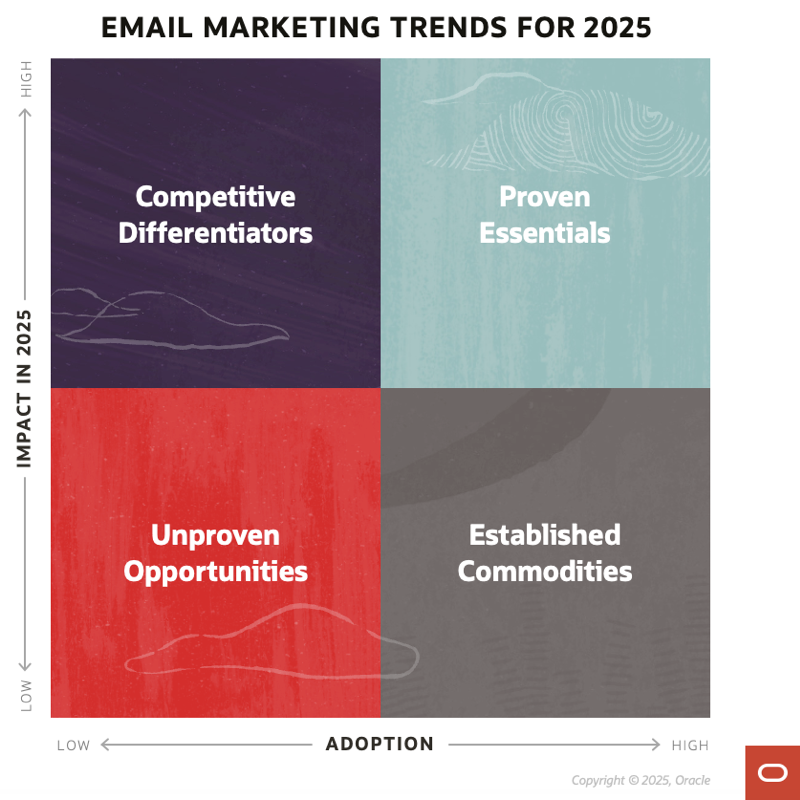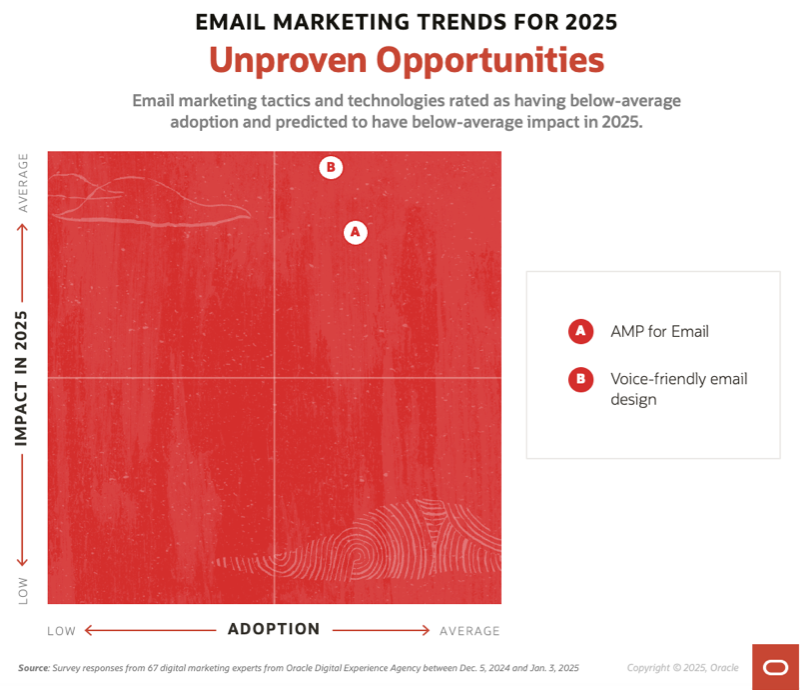Email marketing is constantly evolving, so it can be difficult to know where to invest your time and energy from year to year. Just a few of the recent changes and challenges that email marketers have faced include:
- Economic uncertainty caused by global trade disruptions, high inflation, and high interest rates
- Changes at inbox providers, including broader BIMI support, Apple’s launch of iOS 18, and Gmail’s increasing use of Automatic Extraction
- Generative AI raising concerns and opportunities across the marketing spectrum
To help you prioritize your email marketing efforts this year, we surveyed Oracle Digital Experience Agency’s hundreds of digital marketing experts for the sixth year in a row, asking them to rate the current adoption of a range of email marketing technologies and tactics, as well as the impact they predict each will have in 2025. Then we mapped the results into adoption-impact quadrants.
In this post, we look at the Unproven Opportunities, which are the email trends that were rated low adoption and low impact. The technologies and tactics here are not fully vetted or seen as very effective, and therefore may not generate long-term adoption or impact. There are significant risks that could undermine your investment in part or entirely—including rejection by consumers, inadequate inbox provider support, inadequate digital marketing platform support, the passage of legislative impediments, and other issues.

Because of those risks, most brands will find that the best strategy is to wait and let others work out all the details, uncover the best practices, and stress-test the technologies.
Of the 26 trends we’re highlighting this year, only two of them were rated as being in the low adoption–low impact quadrant for 2025. Moreover, these two trends have been in our Unproven Opportunities quadrant all six years of our survey. Let’s talk about each of them in turn.

A. AMP for Email
Launched in 2019, AMP for email is a set of open standards created by Google for creating what they call “dynamic emails,” which allow marketers to bring functionality that’s common on the web into their email designs. For example, AMP for email allows live forms, carousels, accordions, and hamburger menus to be used in emails. AMP for email also allows for live content that is populated at the time that the email is opened rather than the time the email is sent.
While it had early buzz, the standard quickly faced serious headwinds, including:
- The pandemic, which led to marketing layoffs and massive changes in customer behaviors, and caused marketers to focus on the basics, not “extras” like AMP
- Microsoft halting its AMP for email pilot, which surprised many and stopped the standard from gaining support in another major mailbox
- Google stepping back from AMP for email and shutting down its AMP Fest conference, wanting the standard to stand on its own and not become synonymous with their company
- Google also dramatically deemphasizing AMP for webpages, which caused confusion about AMP for email as people proclaimed, “AMP is dead!”
- Apple launching Mail Privacy Protection, which focused marketers on preserving their email audiences, not on adding new capabilities like AMP for email
All of those challenges aside, the biggest issue is that Apple Mail doesn’t support AMP, and likely never will due to their focus on privacy. Apple Mail has about 50% market share of email opens, according to Litmus, compared to the roughly 30% market share that AMP-supporters Gmail and Yahoo Mail have. That 30% market share is just not enough to make all of the extra development cost worthwhile for marketers.
“I have yet to receive any AMP emails other than those sent by Google itself,” says Henry Alva, Email and Web Developer for Creative Services at Oracle Digital Experience Agency. “There are too many steps, issues, and limited human-assisted support to make it worth it.”
And because of this lack of marketer interest, the vast majority of email service providers (including Oracle) have not made the platform investments needed to support sending the required AMP MIME part.
So, unless Apple has a surprising change of heart, says Sarah Gallardo, Lead Email Developer for Creative Services at Oracle Digital Experience Agency, “AMP is dead, sadly.”
At least that’s true in the US and Europe. In parts of the world like India where Google has much more email open market share than Apple, AMP-powered emails are common and highly effective.
In Apple-dominated markets, marketers should look to enhance their email functionality with CSS-based interactivity and live content.
Related blog post: AMP for Email: The Present & Future of the Standard
B. Voice-Friendly Email Design
While email accessibility and inclusive design have been major trends over the past several years—with each of those having their place—brands haven’t been motivated to make their email designs voice-friendly for screen readers and voice assistants.
This stalled, fledgling trend is held back by three powerful facts:
- We have no idea how many emails are being read via screen readers and voice assistants. While those often trigger tracking pixels, the device isn’t identified.
- Nearly all email marketing calls-to-action currently drive the subscriber to a webpage or mobile app, which is problematic for voice assistants, short-circuiting the path to conversion.
- Rather than reading the plain-text MIME part of an email that could be optimized for verbal communication, screen readers and voice assistants read the HTML MIME part, which is optimized for visual communication.
“From my experience using Apple’s Siri and Amazon’s Alexa voice assistants,” says Alva, “it still has a lot of development needed to be a fully-fledged solution for reading and interacting with email campaigns.”
Until that work happens, our advice is to focus on broader accessibility and inclusive design initiatives, and pay extra attention to voice-optimizing your envelope content. That will allow voice-assistant users to more easily triage their inboxes, deciding which emails to save and engage with later on their phone or computer.
Related blog post: Voice Assistants Reading Emails: How to Create Voice-Friendly Campaigns
Trends on the Move
Long-time readers of our survey will know that Annotations and schema have been an Unproven Opportunity every year of our survey—until now. After five years, it has finally moved up into the Competitive Differentiators quadrant.
For a full look at all 26 email marketing trends to watch for in 2025, also check out our posts that examine:
- Competitive Differentiators, which are high-impact trends with low adoption
- Proven Essentials, which are high-impact trends with high adoption (coming soon)
- The Biggest Shifts in Email Marketing Trends for 2025
Also, for a better understanding of how all of these email marketing trends are evolving, check out our email marketing trends posts from last year:
- Email Marketing Trends for 2024: Unproven Opportunities
- Email Marketing Trends for 2024: Competitive Differentiators
- Email Marketing Trends for 2024: Proven Essentials
- The Biggest Shifts in Email Marketing Trends for 2024
—————
Need help with your email marketing campaigns? Oracle Digital Experience Agency has hundreds of marketing and communication experts ready to help Responsys, Eloqua, Unity, and other Oracle customers create stronger connections with their customers and employees—even if they’re not using an Oracle platform as the foundation of that experience. With a 94% satisfaction rate, our clients are thrilled with the award-winning work our creative, strategy, and other specialists do for them, giving us an outstanding NPS of 70.
For help overcoming your challenges or seizing your opportunities, talk to your Oracle account manager, visit us online, or email us at OracleAgency_US@Oracle.com.
To stay up to date on customer experience best practices and news, subscribe to Oracle Digital Experience Agency’s award-winning, twice-monthly newsletter. View archive and subscribe →
